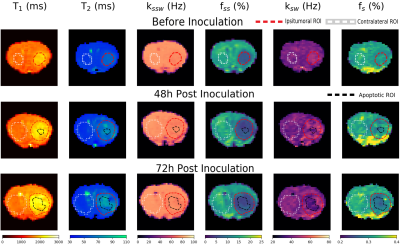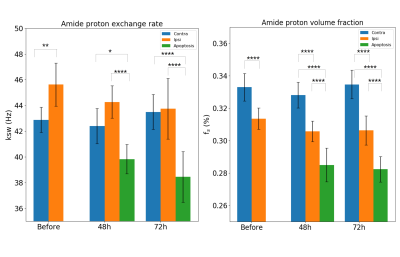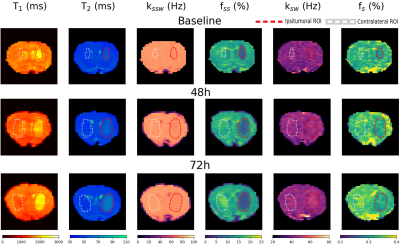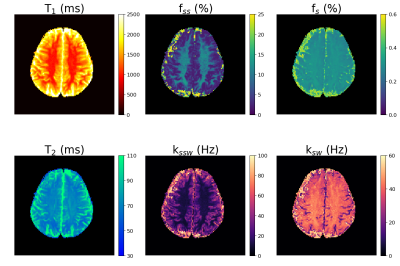0502
Early Detection of Tumor Apoptotic Response to Oncolytic Virotherapy using Deep CEST MR Fingerprinting1Athinoula A. Martinos Center for Biomedical Imaging, Massachusetts General Hospital and Harvard Medical School, Charlestown, MA, United States, 2Brigham and Women’s Hospital and Harvard Medical School, Boston, MA, United States, 3Magnetic Resonance Center, Max Planck Institute for Biological Cybernetics, Tübingen, Germany, 4IMPRS for Cognitive and Systems Neuroscience, University of Tübingen, Tübingen, Germany, 5Department of Neuroradiology, University Clinic Erlangen, Erlangen, Germany, 6Memorial Sloan Kettering Cancer Center, New York, NY, United States, 7Department of Physics, Harvard University, Cambridge, MA, United States
Synopsis
Oncolytic virotherapy (OV) is a promising treatment for high mortality cancers. To optimize the clinical outcome, non-invasive monitoring is essential. The goal of this work was to develop a deep-learning-based technique for quantitative and rapid molecular imaging of OV treatment response. Two CEST MR-fingerprinting protocols were sequentially implemented (105s each) and incorporated within a deep-reconstruction-network, trained to output the quantitative semi-solid and amide pool exchange parameters. The resulting molecular maps allowed early apoptosis detection in brain tumor OV mouse models. Clinical translation of CEST-MRF is demonstrated in a normal human subject and yielded parameters in good agreement with literature values.
Introduction
Oncolytic viruses can selectively destroy tumor tissue while avoiding normal tissues.1 As a result of their promising clinical trials,2,3 they bring hope to currently incurable cancers such as glioblastoma multiforme. Frequent and non-invasive image monitoring of oncolytic virotherapy (OV) would improve our understanding of the interactions between the virus and its tumor-host and help predict the therapeutic response.Chemical exchange saturation transfer (CEST) MRI is a molecular imaging technique capable of detecting protein concentration and pH changes. Previously, we have demonstrated its capability for assisting in OV monitoring by engineering a lysine-rich protein CEST reporter gene into an oncolytic virus.4 However, clinical translation of CEST methods has been hindered by the qualitative nature of the image contrast and the long image acquisition times.
The goal of this work was to develop a deep-learning-based CEST MR fingerprinting (MRF) method for quantitative and rapid multi-pool imaging of OV treatment response without the use of any additional exogenous materials or reporter genes. The approach was evaluated in mice undergoing virotherapy treatment and was translated to clinical scanners.
Methods
CEST-MRF AcquisitionTwo SE-EPI CEST-MRF acquisition protocols (105s each) were employed sequentially,5 designed for obtaining MT and amide proton exchange-rate and volume-fraction maps. The first protocol was specific for the MT pool and varied the saturation power while employing saturation offsets between 6-14 ppm, avoiding the amide contribution, while the second used a fixed 3.5 ppm saturation offset to obtain multi-pool contributions. T1, T2, and B0 maps were acquired using variable repetition-time, multi-echo spin-echo, and water saturation shift referencing (WASSR)6 or the WASABI method,7 respectively. Although not performed here, it is noted that the water pool and B0 maps could also be rapidly obtained using previously established T1/T2 MRF mapping methods,8 further shortening the total acquisition time.
CEST-MRF Dictionary Generation
OV induces changes in a variety of multi-pool parameters throughout the treatment time-course. As a result, a very large dictionary is required for obtaining reasonable parameter-map resolution. The CEST-MRF signal trajectories for 184,800 and 70,224,000 multi-pool parameter combinations were synthesized for the two protocols using a numerical solution of the Bloch-McConnell equations, implemented in Matlab and C++.9,10 The two dictionary simulations took a total of 40hrs using a computer cluster utilizing 56 CPUs.
Deep Reconstruction Networks
To avoid the exceedingly long dictionary matching-time required for conventional dot-product MRF and to improve the multi-parameter reconstruction ability,5 image reconstruction was performed using a series of two Deep RecOnstruction NEtworks (DRONEs),11 trained on the synthesized data. The entire reconstruction scheme can be seen in Fig. 1. The pixel-wise signal trajectories from the MT specific MRF schedule were input to the first DRONE, together with the water T1, T2 and B0 values. The two MT exchange parameter outputs, together with the water pool and B0 parameters were then input into the second DRONE, together with the pixel-wise signal trajectories from the amide-pool MRF schedule. To avoid over-fitting, 10% of each dictionary was excluded from training and was used to assess when to stop the training (“early stopping”). To promote robust learning, 20-dB white Gaussian noise was injected into the dictionaries.12
In Vivo Virotherapy Imaging
All animal procedures were approved by the institutional committee. U87 tumors were implanted in the brain of 16 mice (25% used as control). The mice were imaged at 8-11 days after implantation, using a 7T preclinical MRI (Bruker, Germany). Next, a herpes simplex-derived oncolytic virus, NG34, was inoculated, and the mice were imaged 48hrs and 72hrs later.
Clinical Translation
For clinical translation, the continuous wave saturation pulse was replaced by a train of spin-lock saturation pulses (13x100 ms, 50% duty-cycle13), and the read-out was done using GRE-EPI. The protocol was programmed using the hardware-independent open-source pulseq framework.14 A healthy volunteer was recruited, following IRB approval and informed consent, and imaged at 3T (Siemens Healthineers, Germany).
Results and Discussion
The parameter maps obtained for a representative virotherapy mouse can be seen in Fig. 2, and the entire-group statistical analysis is available in Fig. 3. Before virus inoculation, the semi-solid and amide proton concentrations were both decreased in the tumor, consistent with increased edema decreasing the protein concentrations. The tumor amide proton exchange-rate was increased, indicative of increased intracellular pH. Following OV, the core of the tumor presented significantly lower amide proton concentration and exchange-rate compared to the tumor rim and the contralateral region. Both effects are indicative of apoptosis as it is known to inhibit protein synthesis15 and decrease cytosolic pH.16 The maps obtained for a representative control mouse (tumor without OV) can be seen in Fig. 4. At baseline, control mice demonstrated similar MT and amide effects as OV-treated mice, however, no apoptotic process was evident. The normal human subject parameter maps (Fig. 5) yielded MT volume fraction and exchange-rate values in good agreement with the literature.17 The amide proton exchange-rate was in good agreement with previous water exchange spectroscopy (WEX) based measurements.18 The total reconstruction time for the 4 molecular maps using the neural-network scheme was 94 ms, compared to 2.3 hrs for conventional dot-product reconstruction.Conclusion
The CEST-MRF technique successfully and rapidly quantified pH and molecular concentration changes, potentially serving as important biomarkers for OV-induced apoptosis.Acknowledgements
Grants R01-CA203873, P41-RR14075, 1S10RR023401, 1S10RR019307, and 1S10RR023043. German Research Foundation (DFG, grant ZA 814/2–1, support to K.H.). This project has received funding from the European Union’s Horizon 2020 Research and Innovation Programme under the Marie Skłodowska-Curie grant agreement No. 836752 (OncoViroMRI).References
1. Parato, K. A., Senger, D., Forsyth, P. A., and Bell, J. C. Recent progress in the battle between oncolytic viruses and tumours. Nature Reviews Cancer 2005;5(12):965.
2. Russell, S. J., Peng, K.-W., and Bell, J. C. Oncolytic virotherapy. Nature biotechnology 2012;30(7):658.
3. Ribas, A., Dummer, R., Puzanov, I., VanderWalde, A., Andtbacka, R. H., Michielin, O., Olszanski, A. J., Malvehy, J., Cebon, J., Fernandez, E., et al. Oncolytic virotherapy promotes intratumoral t cell infiltration and improves anti-pd-1 immunotherapy. Cell 2017;170(6):1109–1119.
4. Farrar, C. T., Buhrman, J. S., Liu, G., Kleijn, A., Lamfers, M. L., McMahon, M. T., Gilad, A. A., and Fulci, G. Establishing the lysine-rich protein CEST reporter gene as a CEST mr imaging detector for oncolytic virotherapy. Radiology 2015;275(3):746–754.
5. Perlman, O., Cohen O., Ito H., Nakashima, H., Chiocca, EA., Rosen MS, Farrar, CT. Sequential and deep multi-pool CEST MR fingerprinting in in-vivo tumor-bearing mice. in ISMRM Annual Meeting & Exhibition, 1090. Montreal, QC, Canada: International Society for Magnetic Resonance in Medicine; 2019.
6. Kim, M., Gillen, J., Landman, B. A., Zhou, J., and Van Zijl, P. C. Water saturation shift referencing (wassr) for chemical exchange saturation transfer (CEST) experiments. Magn Reson Med. 2009;61(6):1441–1450.
7. Schuenke, P., Windschuh, J., Roeloffs, V., Ladd, M. E., Bachert, P., and Zaiss, M. Simultaneous mapping of water shift and b1 (wasabi) - application to field-inhomogeneity correction of CEST mri data. Magn Reson Med. 2017;77(2):571–580
8. Ma, D., Gulani, V., Seiberlich, N., Liu, K., Sunshine, J. L., Duerk, J. L., and Griswold, M. A. Magnetic resonance fingerprinting. Nature 2103;495(7440):187.
9. Cohen, O., Huang, S., McMahon, M. T., Rosen, M. S., and Farrar, C. T. Rapid and quantitative chemical exchange saturation transfer (CEST) imaging with magnetic resonance fingerprinting (MRF). Magn Reson Med. 2018;80(6):2449–2463.
10. Perlman, O., Herz, K., Zaiss, M., Cohen, O., Rosen, MS., Farrar, CT. CEST MR‐Fingerprinting: Practical considerations and insights for acquisition schedule design and improved reconstruction. Magn Reson Med. 2019;00:1–17. https://doi.org/10.1002/mrm.27937
11. Cohen, O., Zhu, B., and Rosen, M. S. MR fingerprinting deep reconstruction network (DRONE). Magn Reson Med. 2018;80(3):885–894.
12. Zur, R. M., Jiang, Y., Pesce, L. L., and Drukker, K. Noise injection for training artificial neural networks: A comparison with weight decay and early stopping. Med Phys. 2009;36(10):4810–4818.
13. Roeloffs, V., Meyer, C., Bachert, P., and Zaiss, M. Towards quantification of pulsed spinlock and CEST at clinical MR scanners: an analytical interleaved saturation–relaxation (ISAR) approach. NMR in Biomedicine 2015;28(1), 40-53
14. Layton, K. J., Kroboth, S., Jia, F., Littin, S., Yu, H., Leupold, J., Nielsen, J.-F., Stöcker, T., and Zaitsev, M. Pulseq: a rapid and hardware-independent pulse sequence prototyping framework. Magn Reson Med. 2017;77(4):1544–1552.
15. Jeffrey, I. W., Bushell, M., Tilleray, V. J., Morley, S., and Clemens, M. J. Inhibition of protein synthesis in apoptosis: differential requirements by the tumor necrosis factor α family and a dna-damaging agent for caspases and the double-stranded rna-dependent protein kinase. Cancer Research 2002;62(8):2272–2280.
16. Nilsson, C., Johansson, U., Johansson, A.-C., Kågedal, K., and Öllinger, K. Cytosolic acidification and lysosomal alkalinization during tnf-α induced apoptosis in u937 cells. Apoptosis 2006;11(7):1149.
17 Stanisz, G. J., Odrobina, E. E., Pun, J., Escaravage, M., Graham, S. J., Bronskill, M. J., and Henkelman, R. M. T1, T2 relaxation and magnetization transfer in tissue at 3T. Magn Reson Med. 2005;54(3):507–512.
18. Van Zijl, P. C., Zhou, J., Mori, N., Payen, J.-F., Wilson, D., and Mori, S. Mechanism of magnetization transfer during on-resonance water saturation. a new approach to detect mobile proteins, peptides, and lipids. Magn Reson Med. 2003;49(3):440–449.
Figures




